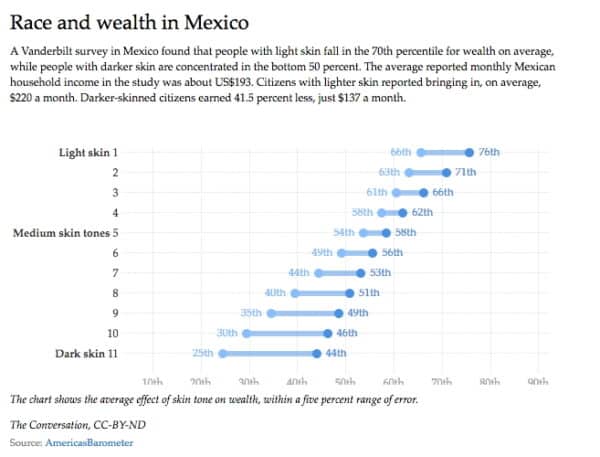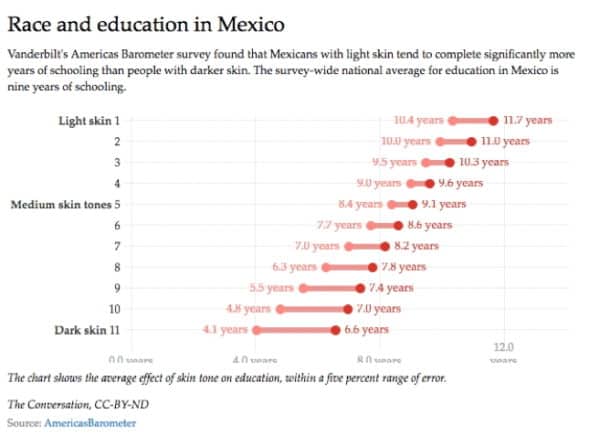Study Reveals Racial Inequality in Mexico, Disproving Its ‘Race-Blind’ Rhetoric
The Conversation, December 13, 2017
{snip}
{snip} Mexicans have divergent ancestry, including Spanish, African, indigenous and German. And while skin color in Mexico ranges from white to black, most people — 53 percent — identify as mestizo, or mixed race.
In Mexico, inequality, though rampant, has long been viewed as a problem related to ethnicity or socioeconomic status, not race.
Our new report suggests that assumption is wrong. Published in November, “Is Mexico a Post-Racial Country?” reveals that in Mexico darker skin is strongly associated with decreased wealth and less schooling. Indeed, race is the single most important determinant of a Mexican citizen’s economic and educational attainment, our results show.
Unequal in every way
The study, published last month by the Latin American Public Opinion Project at Vanderbilt University, or LAPOP, drew on data from the university’s Americas Barometer, a poll of 34 nations across North, Central and South America, as well the Caribbean.
To capture information on race, which is often not reflected in Latin American census data, the pollsters themselves categorized respondents’ face skin tone on a standardized 11-point scale that ranges from darkest to lightest.
We were fascinated to see that the Mexico data clearly showed people with white skin completing more years of schooling than those with browner skin — 10 years versus 6.5. That’s a stunning 45 percent gap in educational achievement between the darkest- and lightest-skinned Mexicans.
Darker-skinned Mexicans surveyed had also completed fewer years of schooling than the survey’s average nationwide finding of nine years.
Wealth, we found, similarly correlates to skin color. The average Mexican household income in the LAPOP study was about US$193 a month. Citizens with lighter skin reported bringing in more than that — on average, $220 a month. Darker-skinned citizens, on the other hand, earned just $137 — 41.5 percent less than their white compatriots.
Overall, populations identified as having the lightest skin fall into the highest wealth brackets in Mexico, while those with the darkest skin are concentrated at the bottom. These dynamics, other studies have found, seem to persist across generations.
Similar disparities emerged when we examined other measures of economic well-being, such as material possessions — like refrigerators and telephones — and basic amenities.
For example, only 2.5 percent of white Mexicans surveyed by Vanderbilt’s pollsters don’t have running water, while upwards of 11 percent of dark-skinned citizens said they lack this basic necessity. Likewise, just 7.5 percent of white Mexicans reported lacking an in-home bathroom, versus 20 percent of dark-skinned Mexicans.
{snip}
{snip} Just last September, President Enrique Peña Nieto declared el mestizaje — racial mixing — as “the future of humanity.”
The data paints a much less rosy picture. Race, it turns out, has a greater impact on a Mexican’s human development and capital accumulation than any other demographic variable. Our results show that Mexico’s “skin-color gap” is two times the achievement gap documented between northern and southern Mexicans, which is an inequality more often cited in Mexico.
It is also five times greater than the urban-rural divide reported in the poll. We even found that skin color has a significantly greater impact on wealth and education than does ethnicity — that is, indigenous versus white or mixed-race Mexican.
{snip}
Our results add to a growing body of academic research highlighting a reality the government doesn’t want to admit: Racism exists in Mexico.
Racial and ethnic biases have so far been documented in Mexico’s allocation of public resources, politics and, notably, the labor market.
A recent report from the National Institute of Statistics, for example, finds that white people comprise 27 percent of all white-collar workers and just 5 percent of the agricultural sector.
{snip}
{snip} Our study accounted for gender, age, region of residence and ethnic origin — and still skin color emerged as a powerful determinant of wealth and education levels.
{snip}
[Editor’s Note: The original Vanderbilt study — with additional charts and graphs — is available here.]

![]()
















